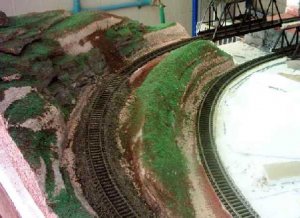This is my first genuine attempt at building a model train. I want to model mountainous/hilly terrain which is found in the Rockie Mountains of Canada, but can't seem to get the proper paint tone. I use a foam base for my hills and mountains. I've tried three different shades of acryllic paints already, and have not been satisfied with any. The first one was too red in color, the second too dark brown, and the third one (as seen in the attached photo) seems too "pink" and only makes my hills look like something from Australia or a tropical country. I bought these paints at a local TOA paint store here in Thailand and they all have numbers indicating the tones (unfortunately the numbers are written on receipts which I keep at work). I don't know whether the numbers are part of an international coding system or only apply to the local paintstores here. They do use a computerized system to mix the paints however, so the chances of them using an international color coding system seems likely too me. I would appreciate if someone could suggest some good color 'numbers' to use for the base if I am modelling the mountains of western Canada. I won't be able to go on with the rest of the layout (such as adding trees and shrubs) until I'm satisfied with the base color of my layout. This is my first post, but I've been visiting this site for tips over the last 6 months and must say that I admire how very friendly and helpful everyone is. It's a very good forum.







